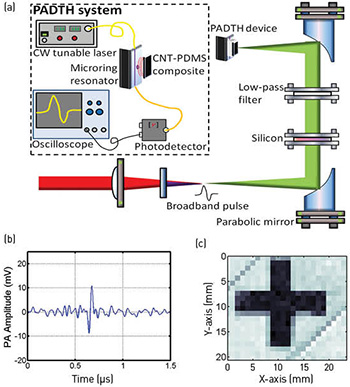 (a) Experimental setup of the PhotoAcoustic Detection of THz (PADTH) system. (b) Photoacoustic signal from the incident THz pulse, signifying the system real-time response capability. (c) THz image of an aluminum cross attached on a strip of scotch tape, made by the PADTH system.
(a) Experimental setup of the PhotoAcoustic Detection of THz (PADTH) system. (b) Photoacoustic signal from the incident THz pulse, signifying the system real-time response capability. (c) THz image of an aluminum cross attached on a strip of scotch tape, made by the PADTH system.
Terahertz (THz) sensing plays an important role in industry, biology and materials science. Most existing techniques for THz detection require either bulky optics or cryogenic cooling; the uncooled thermal detectors usually suffer from a long integration time, which limits their capabilities for real-time detection. To address these issues, we have proposed and experimentally demonstrated a compact, room-temperature, real-time THz detection system that does not directly measure the electromagnetic wave itself, but instead “listens to” the sound wave it generates.
The new method is termed PhotoAcoustic Detection of THz (PADTH) pulse radiation.1 In this scheme, a THz pulse is absorbed by a composite made of carbon nanotube (CNT) and a PDMS elastomer.2 The absorbed electromagnetic energy leads to heating and expansion of the composite and, as a result, generation of ultrasound pulse. The process is referred to as “photoacoustic generation.” The ultrasound signal is then detected by a highly sensitive polymer microring sensor made by imprinting. The resonance wavelength of the polymer microring resonator can be changed by the acoustic pressure, and the microring’s high quality factor (about 105) leads to a sensitive detection of ultrasound wave.3 Utilizing this property, the ultrasound waveform generated from THz absorption can be faithfully recorded by a high-speed photodetector.
Different from the conventional thermal detectors utilizing continuous heat integration, this new method of THz detection responds to the energy of each individual THz pulse, enabling real-time detection and imaging. The new system is compact, operates at room temperature and is sensitive to broadband THz radiation by the extraordinary absorption properties of CNT-polymer composite across wide spectrum range. Moreover, the detection method is essentially a gated measurement, thus eliminating the interference from ambient noise and slow varying electromagnetic waves. All these features are advantageous for practical THz detections and imaging. The concept of “listening to” electromagnetic waves via photoacoustics instead of a direct detection can be expanded to other frequency ranges as well.
Researchers
Sung-Liang Chen, You-Chia Chang, Cheng Zhang, Jong G. Ok, Tao Ling, Momchil T. Mihnev, Theodore B. Norris and L. Jay Guo, University of Michigan, Ann Arbor, Mich., USA
References
1. S.-L. Chen et al. Nat. Photon. 8, 537 (2014).
2. H.W. Baac et al. Sci. Reports 2, 989 (2012).
3. T. Ling et al. Appl. Phys. Lett. 98, 204103 (2011).
